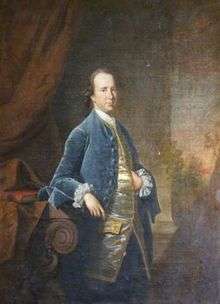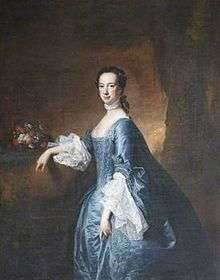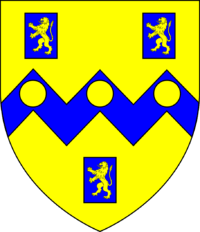Denys Rolle (died 1797)


Denys Rolle (1725–1797) of Hudscott, Beam, Stevenstone and Bicton in Devon and East Tytherley in Hampshire, was an independent Member of Parliament for Barnstaple, Devon, between 1761 and 1774. He was the largest landowner in Devon, with a rent-roll of £40,000 per annum.[2]
He was a philanthropist and generous benefactor to charities and religious societies. A modest man, considered eccentric, his favourite pastime was to perform the work of a common farm-labourer. He was puritanical in morals, opposing ale-houses, cockfighting and bear-baiting, and was humane and tender towards animals claiming a special kinship with wildlife.[2]
He spent much of his life attempting to establish an "ideal society", a Utopian colony of poor, homeless or criminal English persons on about 80,000 acres in Florida named Rollestown or Charlotta. On the failure of that venture he turned to slave labour, and on the loss of Florida as a British possession moved his colony to a smaller site on Exuma in the Bahama Islands. He was deemed by many to be stubborn, high-handed, irascible, litigious, and a megalomaniac, even stupid, and lacking diplomatic skills.[3]
Early life and family

The Rolle family was one of the richest and most powerful in Devon and owned several dozen manors, their most ancient holding being Stevenstone near Great Torrington in the north of the county, whilst Bicton in the south-east was the centre of another large block of territory.
Denys Rolle was the youngest of four sons of John Rolle (1679–1730), of Bicton and Stevenstone, by his wife Isabella Charlotte Walter, daughter of Sir William Walter, 2nd Baronet of Sarsden, Oxfordshire. His eldest brother was Henry Rolle, 1st Baron Rolle (died 1759) of Stevenstone, whose heir was his next younger brother John Rolle Walter (c. 1714 – 1779), who was a Tory MP. Denys was baptised on 19 July 1725 in St Giles's Church,[4] St Giles in the Wood, the parish church of Stevenstone. He matriculated at New College, Oxford on 19 January 1742, at the age of 16.[5]
He was named after his cousin Denys Rolle (1614–1638), of Stevenstone, who had inherited Bicton and other lands from his mother Ann Denys, a co-heiress of the ancient Devon family of Denys of Holcombe Burnell.
Inheritances
As the fourth son Denys Rolle had been born with no expectation of inheriting the vast Rolle estates of his father. He had been provided for his residence with the Rolle manor of Beam near Great Torrington.[6] However he received a three-fold inheritance which, together with his own land purchases around Otterton in South Devon, meant that on his death he was the largest land owner in the county of Devon, the second largest county in England.
His eldest brother Henry Rolle, 1st Baron Rolle (died 1759) had inherited his paternal estates in 1730 but had died childless in 1759 when his heir was his younger brother John Rolle Walter (c. 1714–1779), who in 1731 at the age of 17 had inherited the Oxfordshire lands of his childless uncle Sir Robert Walter, 4th Baronet (1680–1731), of Sarsden in Oxfordshire and had changed his name to Walter, as required by the bequest.
The third brother, William Rolle (1720 – c.1747) of Beam, had died childless after 1747[7] which left Denys Rolle as the heir to the Rolle and Walter lands. However Denys had also inherited the estate of Hudscott in the parish of Chittlehampton, Devon, from his distant childless cousin Samuel Rolle (1704–1747) son and heir of Samuel Rolle (1669–1735) of Hudscott, MP for Barnstaple. This inheritance included a moiety of the manor of Countisbury in North Devon.[8] He also inherited the manors of East Tytherley in Somerset and Shapwick in Somerset, which had been acquired by his cousin Henry Rolle (1589–1656),[9] Chief Justice of the King’s Bench, descended from the most junior Rolle line.
Thus at the age of about 21 Denys Rolle had inherited Hudscott, where he lived during most of his life and where several of his children were baptised. In 1779 at the age 54, following the death of his brother John Rolle Walter, he inherited the paternal Rolle estates of Stevenstone and Bicton.
Philanthropy
Rolle established several charity schools on different parishes and allocated to each a plot of land for the employment of the children.[2] In 1790 he rebuilt part of St Giles's Church, the parish church of Stevenstone, which is commemorated by a stone heraldic escutcheon above the north transept door inscribed "DR 1790".[10]
Land purchases
Florida
In May 1764 Rolle obtained a grant from the crown of 20,000 acres of land for a plantation in St Mark's in the Bay of Apalatchi in East Florida, which area had recently been ceded by Spain to Great Britain following the Seven Years' War. One of the numerous conditions was that he should settle it with white Protestants.[11] He embarked for America on 10 June 1764 and arrived at Charleston on 12 August 1764[5] and was in St Augustine, capital of East Florida, by September 1764[12] He soon discovered that this land was unsuitable and instead, with the permission of the Governor of East Florida James Grant (1720–1806), settled with 14 settlers[5] on the east bank of the St Johns River, above today's East Palatka, which site he named Charlotta in honour of the Queen, later Charlotia, later Rollestown, thought to be on the site of today's San Mateo.[3]
Having quarrelled with Governor Grant and been refused further grants of land, he returned to England in October 1765. There he addressed his long and detailed "Humble Petition" to the Board of Trade complaining of his treatment. He returned to Florida however in September 1766 with a further 50 settlers.[13] He returned to England again in January 1768, soon after which he was elected MP for Barnstaple, and stayed to pursue his political career.[5] Rolle's settlers were in the opinion of observers deemed low quality, of poor morality, indisciplined and not capable of hard work. Soon due to Rolle's harsh management style and their own unsuitability his colonists rebelled and deserted to Georgia or South Carolina, whereupon Rolle gave up his Utopian ideals and employed African slave labour. The plantation produced among other crops rice, corn and turpentine tar from pine trees for naval use. He acquired a further 20,000 acres from William Elliot and 20,000 from John Grayhurst, 10,000 from William Penrice and 3,000 from James Cusack, all on the eastern side iof the St Johns River. He acquired a further 1,500 acres on the west side from Joseph Gray.[14]
Rollestown was visited in December 1765 by the naturalists John Bartram and his son William Bartram, and again in 1778, the latter who recorded his observations in a journal which survives.[15] Rolle's activities were also recorded in the diary, correspondence and official reports of the Governor of Florida James Grant, who became increasingly infuriated by Rolle's constant demands, complaints and disputes[16]
Bahamas
Following the Treaty of Versailles in 1783 Florida was ceded by the British government to Spain, and Rolle was thus forced to abandon his colony. He suffered great financial loss and claimed substantial compensation from the British government, which offered him instead a new much smaller colony on the British island of Exuma in the Bahama Islands, about 500 miles to the south-east, to which he removed whatever livestock, equipment and slaves he was able to transport. His son and heir Lord Rolle later freed his slaves, many of whom thereupon adopted the surname of Rolle, and donated to them his Exuma estate. The land is still today held by their descendants as common property, "generation land", controlled by locally elected officials.[17]
Although the name Rolle died out in England on the death of Lord Rolle in 1842 (revived for a while in the person of his heir Mark Rolle (d.1907)), the surname Rolle is still in the 21st century a common name in the Bahamas, for example the actress Esther Rolle, born in Pompano Beach, Florida, of Bahamian parents; Myron Rolle, the Bahamian National Football League player, team member of the Tennessee Titans and Rhodes Scholar; and Magnum Rolle, a professional basketball player born in Freeport, Bahamas, in 1986.
Otterton & East Budleigh
In 1786 he purchased for the huge sum of £72,000 the manors of Otterton and East Budleigh, situated adjacent to Bicton in south-east Devon from the heirs of the Duke family, descendants of Richard Duke (died 1572) who in 1540 had purchased the former lands of Otterton Priory following the Dissolution of the Monasteries. The properties acquired included:[18]
"Capital messuage, barton farm and demesne lands of Otterton and the manors and lordships of Otterton, Little Otterton, Budleigh Poleslow (otherwise Higher Budleigh), Budleigh Syon (otherwise Lower Budleigh), Collaton Rawleigh (otherwise the Lower Manor), Dukes-Collaton, (otherwise Collaton Abbott otherwise The Higher Manor), Dotton (otherwise Docton) and Hays (otherwise Powershays otherwise Dukes Hayes); 4 water grist mills in Otterton and the advowsons of the churches of Otterton, Budleigh and Harpford with the free chapels of Withecombe, Fen Ottery, Rectory and Sheaf of Otterton and a fee farm rent of £13. 10s., payable out of the sheaf of Sidmouth, etc."
Land sales
Rolle sold his Somerset estate of Shapwick in 1786/7[19] to George Templer (1755–1819), of the East India Company, 4th son of James I Templer (1722–1782) of Stover, Teigngrace.
Marriage and children
On 22 May 1750 in East Down, Devon,[4] Denys Rolle married Anne Chichester (1721–1781),[20] a daughter (by his second wife) of Arthur Chichester (1670-1737/8) of Hall, Bishop's Tawton, Devon,[21] a junior line of the ancient and prominent Chichester family of Raleigh. By Anne he had the following children:[22]
- John Rolle, 1st Baron Rolle (1751–1842), eldest son and heir, baptised at Chittlehampton[22]
- Denys Bruce Rolle (born 1758), presumed died young, baptised at Chittlehampton[22]
- Samuel Rolle (born 1759), presumed died young, baptised at Chittlehampton[22]
- Isabella Henrietta Charlotte Rolle (1754–1770), eldest daughter, died aged 16,[23] baptised at Chittlehampton[22]
- Anne Rolle (1755–1842) , 2nd daughter, baptised at East Tytherley, died 16 June 1842 aged 87.[23] In her old age she was allowed by her brother Lord Rolle to live with her sister Lucilla at Hudscott
- Lucilla Rolle (1757–1851), baptised at East Tytherley, died 24 July 1851 aged 94.[23] In her old age she was allowed by her brother Lord Rolle to live with her sister Anne at Hudscott but after the latter's death and the death of Lord Rolle both in 1842 she was declared a lunatic in 1846.[24]
- Christiana Philippa Maria Rolle (1759–1831), died 3 February 1831, Aged 72.[23]
- Florence Rolle (born 1762)[22]
Death
Rolle died on 26 June 1797, aged 72, of angina during one of his habitual long walks between his manors of Hudscott and Stevenstone,[2] and was buried in St Giles's Church on 1 July 1797[23] The vicar and historian of Chittlehampton, Rev. J.H.B. Andrews, wrote:
Deadman's, later known as South Nethercleave, where the house is now derelict, was 65 acres. This is said to take its name from the fact that Denys Rolle, who although he was the richest man in Devonshire always preferred to walk, died under a tree there in 1797 while walking from Hudscott to Stevenstone.[25]
In St Giles Church, St Giles in the Wood, there is a mural monument to Rolle, erected by Anne, his second daughter.
References
- ↑ Collection of Great Torrington Almshouse, Town Lands and Poors Charities, Rolle/Clinton Art Collection
- 1 2 3 4 Gentleman's Magazine, July 1797, p.617, Obituary of Denys Rolle
- 1 2 White
- 1 2 "St Giles in the Wood Monumental Inscriptions".
- 1 2 3 4 Drummond
- ↑ Per National Archives C11/569/28 Court of Chancery, document dated 1747: "Denys Rolle Esquire late of Beam and now of Hudscott
- ↑ Will of William Rolle of Beam dated 1747 (National Archives)
- ↑ "Full text of "Report and Transactions - The Devonshire Association for the Advancement of Science, Literature ..."".
- ↑ Hunneyball, Paul, Biography of Henry Rolle published in History of Parliament: House of Commons 1604–1629 ed. Andrew Thrush and John P. Ferris, 2010
- ↑ St Giles's Church, Information Leaflet, p.3
- ↑ Terms of grant quoted in Observations of Denys Rolle
- ↑ Drummond, quoting letter from Governor Grant
- ↑ observations of Denys Rolle
- ↑ Florida History Online: Denys Rolle and Rollestown
- ↑ See: Bartram, William, Travels in North and South Carolina, Georgia, East and West Florida, Penguin Books, 1988
- ↑ "English Plantations on the St. Johns River".
- ↑ http://www.seaworthy.com
- ↑ Devon Record Office 48/22/1/2 Conveyance dated 25 March 1786
- ↑ Dunning, Robert, History of the County of Somerset, Vol.8, 2004, pp.160–179
- ↑ Vivian, p.177, pedigree of Chichester of Hall, Anne was baptised 11 October 1721 at Bishops Tawton; Per her husband's monument in St Giles's Church, St Giles-in-the-Wood, Devon, she died 24 May 1781 "aged 64"(sic)
- ↑ Vivian, Heralds' Visitations of Devon, 1895, p.177, pedigree of Chichester of Hall
- 1 2 3 4 5 6 Vivian, p.656
- 1 2 3 4 5 Monument in St Giles's Church, St Giles-in-the-Wood, Devon: St Giles in the Wood Monumental Inscriptions
- ↑ Lucilla Rolle, spinster of Hudscott, Devon: commission and inquisition of lunacy, into her state of mind and her property, female lunatic, 1846 Sept 17. National Archives C 211/22/R134
- ↑ Articles from Chittlehampton Parish Magazine OLD CHITTLEHAMPTON – FARMING written by Rev. J.H.B. Andrews
Sources
- Drummond, Mary M., biography of Denys Rolle published in History of Parliament: House of Commons 1754–1790, ed.. L. Namier, J. Brooke, 1964
- Vivian, Lt.Col. J.L., (Ed.) The Visitations of the County of Devon: Comprising the Heralds' Visitations of 1531, 1564 & 1620, Exeter, 1895, pp. 652–656, pedigree of Rolle
- Obituary of Denys Rolle, Gentleman's Magazine, July 1797, p.617 & Supplement 1797, p.1125
- White, Theresa Ann, Charlotta: The Failed Utopia
Further reading
- Legg, Robert, A Pioneer in Xanadu: Denys Rolle: 1725–1797, London, 1997
- Bailyn, Bernard, Failure in Xanadu: Voyagers to the West: A Passage in the Peopling of America on the Eve of the Revolution, New York: Alfred A. Knopf, 1986, pp. 447–51
- The Memorial of Denys Rolle, East Florida, 1780, T77/15/13, folios 210-3
- Corse, Carita Doggett, Denys Rolle and Rollestown: A Pioneer for Utopia, Florida Historical Society Quarterly, October 1928
- Bohnenberger, Carl, The Settlement of Charlotia (Rolles Town) 1765, Florida Historical Society Quarterly, July 1925
- Bartram, William, Travels in North and South Carolina, Georgia, East and West Florida, Penguin Books, 1988
- The Humble Petition of Denys Rolle, Esq., Setting Forth the Hardships, Inconveniences, and Grievances Which Have Attended Him in His Attempts to Make a Settlement in East Florida, Humbly Praying Such Relief as in their Lordships Wisdom Shall Seem Meet, 1765. Facsimile 137 pages published 1977 by University Press of Florida, ed. Claude C. Sturgill.
- Stork, Dr William & Rolle, Denys, An Extract from the Account of East Florida Published by Dr Stork who Resided a Considerable Time in Augustine the Metropolis of that Province, with the Observations of Denys Rolle who Formed a Settlement on St John's River in the Province of East Florida with his Proposals to Such Persons as may be Inclined to Settle Thereon. (Signed by Denys Rolle at East Tytherley 1 September 1766), published in London 1766
- Mowat, C.L., The Tribulations of Denys Rolle, JSTOR, 1944
| Parliament of Great Britain | ||
|---|---|---|
| Preceded by John Harris George Amyand |
Member of Parliament for Barnstaple 1761 – 1774 With: George Amyand to 1766 John Clevland from 1766 |
Succeeded by William Devaynes John Clevland |